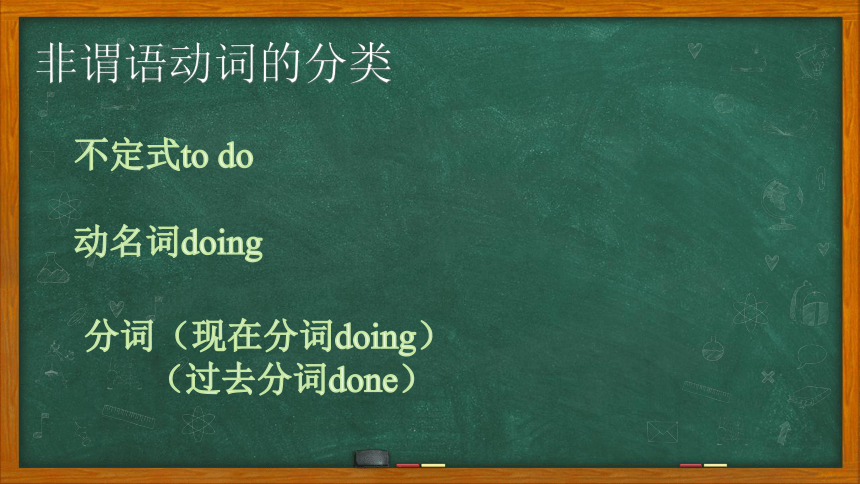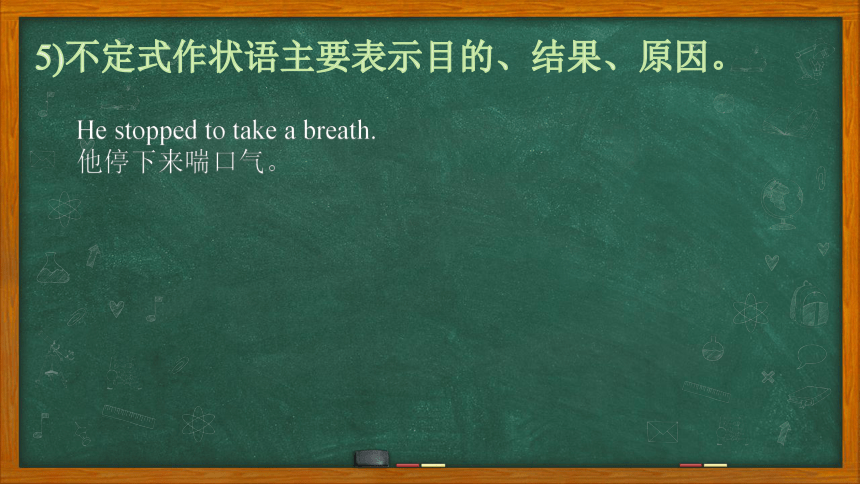外研版中考英语二轮语法总复习课件--非谓语动词
文档属性
| 名称 | 外研版中考英语二轮语法总复习课件--非谓语动词 |

|
|
| 格式 | pptx | ||
| 文件大小 | 4.1MB | ||
| 资源类型 | 试卷 | ||
| 版本资源 | 外研版 | ||
| 科目 | 英语 | ||
| 更新时间 | 2023-12-04 21:19:58 | ||
图片预览









文档简介
(共23张PPT)
非谓语动词
主讲老师:Kelly
考点解读
01
本章要求考生理解非谓语动词的含义,掌握非谓语动词的三种形式及其用法。它是历年高职高考里必考的知识之一。
题型:语法选择题和语法填空题。
非谓语动词的分类
不定式to do
动名词doing
分词(现在分词doing) (过去分词done)
不定式的用法
1) 做主语,谓语动词用单数。
To learn English makes me happy.
学习英语使我快乐。
To stop the work now seems impossible.
现在要停止这项工作似乎是不可能的。
动词不定式作主语时,往往用it作形式主语,而把不定式短语放在谓语后面。
结构一:It is +adj.+for/of + sb. to do sth.
结构二:It is/was + adj.+to do sth.
It’ s necessary for us to help each other.
It is not easy to work out the problem.
2)疑问词who,what,which,when,where,how,why可以加在不定式的前面,构成不定式短语,在句中可以作主语、宾语、表语等。
Where to go is not known yet.
去哪里还不知道。
When to have a picnic depends on the weather.
什么时候去野餐取决于天气。
3)常见带动词不定式作宾语的动词有:
My brother expects to find a good job soon.
我弟弟希望很快能找到一份好工作。
He wanted to leave right now.
他想马上离开。
want,like,wish,hate,agree,hope,try,ask,start,plan,learn,begin, decide,refuse,expect,fail等。
Kelly老师温馨提示:
搭配口诀记忆效果更佳呦!
4)使役动词、感官动词等用在主动语态时,其后则接不带to的不定式,常见有:
We often hear her sing the songs.
我们经常听到她唱歌。
let,make,discover,feel,have,hear,notice,see,watch。
Kelly老师温馨提示:
搭配口诀记忆效果更佳呦!
5)不定式作状语主要表示目的、结果、原因。
He stopped to take a breath.
他停下来喘口气。
( )1.Mary doesn’t have to be made .She always works hard.
A.learn B.learned
C.to learn D.learning
【答案】C
【解析】make后接不带to的不定式,因为是被动语态所以to不可省略,所以答案为C。句意:不必强迫玛丽学习。她总是努力工作。
( )2.The patient was warned any food after the operation.
A.not to eat B.to eat not
C.eating not D.not eating
【答案】A。病人被警告手术后不要吃任何食物。warn sb. not to do sth.
动名词的用法
1) 做主语,谓语动词用单数。
Seeing is believing.
眼见为实
在It is no use/no good/no fun等句型中,it作形式主语,动名词(真实主语)置于句尾作后置主语。
如:It is no use asking her for advice.
征求她的意见没有用
结构:It is no use/good/harm doing sth.
用于布告形式的省略结构中。如:
No smoking!
=No smoking is allowed(here)!
No parking!
2)可以接动名词作宾语的常见动词有:
When he heard the news, he couldn’t help crying.
当他听到这个消息时,禁不住哭了起来。
I enjoy listening to music.
我喜欢听音乐。
I suggested eating out tonight.
我建议今晚出去吃饭。
suggest,finish,mind,enjoy,miss,dislike,admit,risk,
delay,imagine,include,keep等。
Kelly老师温馨提示:
搭配口诀记忆效果更佳呦!
3)可以接动名词作介词的宾语有:
句型一:have + difficulty/trouble +(in) doing
句型二:spend +时间/金钱+(in) doing
句型三:prevent /stop + ....+from doing sth.
句型四:be used to(习惯于),stick to (坚持),lead to(导致),look forward to(期待)
4)加不定式和动名词均可,但意义截然不同。
不定式 (to do) 动名词 (doing)
1 forget to do忘了要做什么 forget doing忘了做过的事情
2 try to do 努力做 try doing 尝试做
3 regret to do 遗憾地去做什么 regret doing
后悔做了什么
4 stop doing 停止做 stop to do
停下来去做另一件事
5 mean to do 打算做 mean doing 意味着做
6 go on to do 继续去做另一件事 go on doing
继续做同一件事
7 remember to do 记的去做某事 remember doing
记的做过某事
( )1.Don’t forget to me.Let’s keep in touch.
A.to write B.writing
C.having written D.to have written
【答案】A
【解析】该题动词forget后既可以跟不定式,也可以跟动名词,但含义不同,forget to do(忘了要做什么),forget doing
(忘了做过的事情)。该句的意思为“别忘了给我写信,让我们保持联系”,而且不用完成形式。所以选A。
分词的用法
①现在分词由动词原形加ing构成(doing),否定式由not+现在分词构成。
②过去分词的基本形式是“动词+ed”(done),否定式由not+过去分词构成。
现在分词
表进行、表主动
Developing country
发展中国家(进行)
Who is the girl speaking to our English teacher
正在跟我们英语老师讲话的那个女孩是谁?(主动)
过去分词
表完成、表被动
Developed country
发达国家(完成)
What is the language spoken in Canada
加拿大讲什么语言?(被动)
现在分词通常指物,表示“令人....的”
I think the film is really moving.
我认为这部电影确实感人。
过去分词通常指人,表示“感到....的”
The audience were deeply moved.
观众们被深深地感动了。
( )1.The film was so that everybody was to tears.
A.moving;moved B.moved;moving
C.moved;moved D.moving;moving
【答案】A
【解析】该题是分词用作表语,现在分词通常表示主动意义,过去分词通常表示被动意义。moving意思为“令人感动的”,
moved意思为“被感动的”。
( )2. what to do,he telephoned me for help.
A.Not knowing B.Knowing not
C.Not to know D.To know not
【答案】A
【解析】现在分词的否定形式为not+现在分词,该句是现在分词作原因状语,而不定式不能作原因状语。
看
观
谢
谢
非谓语动词
主讲老师:Kelly
考点解读
01
本章要求考生理解非谓语动词的含义,掌握非谓语动词的三种形式及其用法。它是历年高职高考里必考的知识之一。
题型:语法选择题和语法填空题。
非谓语动词的分类
不定式to do
动名词doing
分词(现在分词doing) (过去分词done)
不定式的用法
1) 做主语,谓语动词用单数。
To learn English makes me happy.
学习英语使我快乐。
To stop the work now seems impossible.
现在要停止这项工作似乎是不可能的。
动词不定式作主语时,往往用it作形式主语,而把不定式短语放在谓语后面。
结构一:It is +adj.+for/of + sb. to do sth.
结构二:It is/was + adj.+to do sth.
It’ s necessary for us to help each other.
It is not easy to work out the problem.
2)疑问词who,what,which,when,where,how,why可以加在不定式的前面,构成不定式短语,在句中可以作主语、宾语、表语等。
Where to go is not known yet.
去哪里还不知道。
When to have a picnic depends on the weather.
什么时候去野餐取决于天气。
3)常见带动词不定式作宾语的动词有:
My brother expects to find a good job soon.
我弟弟希望很快能找到一份好工作。
He wanted to leave right now.
他想马上离开。
want,like,wish,hate,agree,hope,try,ask,start,plan,learn,begin, decide,refuse,expect,fail等。
Kelly老师温馨提示:
搭配口诀记忆效果更佳呦!
4)使役动词、感官动词等用在主动语态时,其后则接不带to的不定式,常见有:
We often hear her sing the songs.
我们经常听到她唱歌。
let,make,discover,feel,have,hear,notice,see,watch。
Kelly老师温馨提示:
搭配口诀记忆效果更佳呦!
5)不定式作状语主要表示目的、结果、原因。
He stopped to take a breath.
他停下来喘口气。
( )1.Mary doesn’t have to be made .She always works hard.
A.learn B.learned
C.to learn D.learning
【答案】C
【解析】make后接不带to的不定式,因为是被动语态所以to不可省略,所以答案为C。句意:不必强迫玛丽学习。她总是努力工作。
( )2.The patient was warned any food after the operation.
A.not to eat B.to eat not
C.eating not D.not eating
【答案】A。病人被警告手术后不要吃任何食物。warn sb. not to do sth.
动名词的用法
1) 做主语,谓语动词用单数。
Seeing is believing.
眼见为实
在It is no use/no good/no fun等句型中,it作形式主语,动名词(真实主语)置于句尾作后置主语。
如:It is no use asking her for advice.
征求她的意见没有用
结构:It is no use/good/harm doing sth.
用于布告形式的省略结构中。如:
No smoking!
=No smoking is allowed(here)!
No parking!
2)可以接动名词作宾语的常见动词有:
When he heard the news, he couldn’t help crying.
当他听到这个消息时,禁不住哭了起来。
I enjoy listening to music.
我喜欢听音乐。
I suggested eating out tonight.
我建议今晚出去吃饭。
suggest,finish,mind,enjoy,miss,dislike,admit,risk,
delay,imagine,include,keep等。
Kelly老师温馨提示:
搭配口诀记忆效果更佳呦!
3)可以接动名词作介词的宾语有:
句型一:have + difficulty/trouble +(in) doing
句型二:spend +时间/金钱+(in) doing
句型三:prevent /stop + ....+from doing sth.
句型四:be used to(习惯于),stick to (坚持),lead to(导致),look forward to(期待)
4)加不定式和动名词均可,但意义截然不同。
不定式 (to do) 动名词 (doing)
1 forget to do忘了要做什么 forget doing忘了做过的事情
2 try to do 努力做 try doing 尝试做
3 regret to do 遗憾地去做什么 regret doing
后悔做了什么
4 stop doing 停止做 stop to do
停下来去做另一件事
5 mean to do 打算做 mean doing 意味着做
6 go on to do 继续去做另一件事 go on doing
继续做同一件事
7 remember to do 记的去做某事 remember doing
记的做过某事
( )1.Don’t forget to me.Let’s keep in touch.
A.to write B.writing
C.having written D.to have written
【答案】A
【解析】该题动词forget后既可以跟不定式,也可以跟动名词,但含义不同,forget to do(忘了要做什么),forget doing
(忘了做过的事情)。该句的意思为“别忘了给我写信,让我们保持联系”,而且不用完成形式。所以选A。
分词的用法
①现在分词由动词原形加ing构成(doing),否定式由not+现在分词构成。
②过去分词的基本形式是“动词+ed”(done),否定式由not+过去分词构成。
现在分词
表进行、表主动
Developing country
发展中国家(进行)
Who is the girl speaking to our English teacher
正在跟我们英语老师讲话的那个女孩是谁?(主动)
过去分词
表完成、表被动
Developed country
发达国家(完成)
What is the language spoken in Canada
加拿大讲什么语言?(被动)
现在分词通常指物,表示“令人....的”
I think the film is really moving.
我认为这部电影确实感人。
过去分词通常指人,表示“感到....的”
The audience were deeply moved.
观众们被深深地感动了。
( )1.The film was so that everybody was to tears.
A.moving;moved B.moved;moving
C.moved;moved D.moving;moving
【答案】A
【解析】该题是分词用作表语,现在分词通常表示主动意义,过去分词通常表示被动意义。moving意思为“令人感动的”,
moved意思为“被感动的”。
( )2. what to do,he telephoned me for help.
A.Not knowing B.Knowing not
C.Not to know D.To know not
【答案】A
【解析】现在分词的否定形式为not+现在分词,该句是现在分词作原因状语,而不定式不能作原因状语。
看
观
谢
谢
同课章节目录
- 词法
- 名词
- 动词和动词短语
- 动词语态
- 动词时态
- 助动词和情态动词
- 非谓语动词
- 冠词
- 代词
- 数词和量词
- 形容词副词及其比较等级
- 介词和介词短语
- 连词和感叹词
- 构词法
- 相似、相近词比较
- 句法
- 陈述句
- 一般疑问句和否定疑问句
- 特殊疑问句及选择疑问句
- 反意疑问句
- 存在句(There be句型)
- 宾语从句
- 定语从句
- 状语从句
- 主谓一致问题
- 简单句
- 并列句
- 复合句
- 主谓一致
- 主、表语从句
- 名词性从句
- 直接引语和间接引语
- 虚拟语气
- 感叹句
- 强调句
- 倒装句
- 祈使句
- 句子的成分
- 句子的分类
- 题型专区
- 单项选择部分
- 易错题
- 完形填空
- 阅读理解
- 词汇练习
- 听说训练
- 句型转换
- 补全对话
- 短文改错
- 翻译
- 书面表达
- 任务型阅读
- 语法填空
- 其他资料
